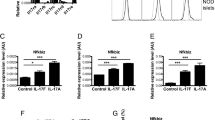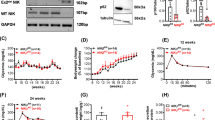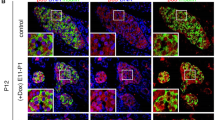Abstract
Destruction of insulin-producing pancreatic β-cells by local autoimmune inflammation is a hallmark of type 1 diabetes. Histochemical analysis of pancreases from non-obese diabetic mice indicated activation of the transcription factor JunB/AP-1 (activator protein-1) after autoimmune infiltration of the islets. In vitro studies demonstrated that the cytokines tumor necrosis factor (TNF)-α and interferon (IFN)-γ induce JunB expression as a protective mechanism against apoptosis in both human and rodent β-cells. The gene network affected was studied by microarray analysis showing that JunB regulates nearly 20% of the cytokine-modified β-cell genes, including the transcription factor ATF3. Direct transcriptional induction of ATF3 by JunB is a key event for β-cell survival after TNF-α+IFN-γ treatment. Moreover, pharmacological upregulation of JunB/ATF3 via increased cAMP protected rodent primary β-cells and human islet cells against pro-inflammatory mediators. These results were confirmed in genetically modified islets derived from Ubi-JunB transgenic mice. Our findings identify ATF3 as a novel downstream target of JunB in the survival mechanism of β-cells under inflammatory stress.
This is a preview of subscription content, access via your institution
Access options
Subscribe to this journal
Receive 50 print issues and online access
$259.00 per year
only $5.18 per issue
Buy this article
- Purchase on Springer Link
- Instant access to full article PDF
Prices may be subject to local taxes which are calculated during checkout






Similar content being viewed by others
References
Allagnat F, Cunha D, Moore F, Vanderwinden JM, Eizirik DL, Cardozo AK . (2011). Mcl-1 downregulation by pro-inflammatory cytokines and palmitate is an early event contributing to β-cell apoptosis. Cell Death Differ 18: 328–337.
Borchers AT, Uibo R, Gershwin ME . (2010). The geoepidemiology of type 1 diabetes. Autoimmun Rev 9: A355–A365.
Bosi E . (2010). Time for testing incretin therapies in early type 1 diabetes? J Clin Endocrinol Metab 95: 2607–2609.
Cardozo AK, Ortis F, Storling J, Feng YM, Rasschaert J, Tonnesen M et al. (2005). Cytokines downregulate the sarcoendoplasmic reticulum pump Ca2+ ATPase 2b and deplete endoplasmic reticulum Ca2+, leading to induction of endoplasmic reticulum stress in pancreatic β-cells. Diabetes 54: 452–461.
Carrington EM, McKenzie MD, Jansen E, Myers M, Fynch S, Kos C et al. (2009). Islet β-cells deficient in Bcl-xL develop but are abnormally sensitive to apoptotic stimuli. Diabetes 58: 2316–2323.
Colli ML, Moore F, Gurzov EN, Ortis F, Eizirik DL . (2010). MDA5 and PTPN2, two candidate genes for type 1 diabetes, modify pancreatic β-cell responses to the viral by-product double-stranded RNA. Hum Mol Genet 19: 135–146.
Cunha DA, Hekerman P, Ladriere L, Bazarra-Castro A, Ortis F, Wakeham MC et al. (2008). Initiation and execution of lipotoxic ER stress in pancreatic β-cells. J Cell Sci 121: 2308–2318.
Cunha DA, Ladriere L, Ortis F, Igoillo-Esteve M, Gurzov EN, Lupi R et al. (2009). Glucagon-like peptide-1 agonists protect pancreatic β-cells from lipotoxic endoplasmic reticulum stress through upregulation of BiP and JunB. Diabetes 58: 2851–2862.
Eferl R, Wagner EF . (2003). AP-1: a double-edged sword in tumorigenesis. Nat Rev Cancer 3: 859–868.
Eizirik DL, Colli ML, Ortis F . (2009). The role of inflammation in insulitis and β-cell loss in type 1 diabetes. Nat Rev Endocrinol 5: 219–226.
Eizirik DL, Mandrup-Poulsen T . (2001). A choice of death—the signal-transduction of immune-mediated β-cell apoptosis. Diabetologia 44: 2115–2133.
Galluzzi L, Aaronson SA, Abrams J, Alnemri ES, Andrews DW, Baehrecke EH et al. (2009). Guidelines for the use and interpretation of assays for monitoring cell death in higher eukaryotes. Cell Death Differ 16: 1093–1107.
Gurzov EN, Germano CM, Cunha DA, Ortis F, Vanderwinden JM, Marchetti P et al. (2010). p53 up-regulated modulator of apoptosis (PUMA) activation contributes to pancreatic β-cell apoptosis induced by proinflammatory cytokines and endoplasmic reticulum stress. J Biol Chem 285: 19910–19920.
Gurzov EN, Ortis F, Bakiri L, Wagner EF, Eizirik DL . (2008). JunB inhibits ER stress and apoptosis in pancreatic beta cells. PLoS ONE 3: e3030.
Gurzov EN, Ortis F, Cunha DA, Gosset G, Li M, Cardozo AK et al. (2009). Signaling by IL-1β+IFN-γ and ER stress converge on DP5/Hrk activation: a novel mechanism for pancreatic β-cell apoptosis. Cell Death Differ 16: 1539–1550.
Heimberg H, Heremans Y, Jobin C, Leemans R, Cardozo AK, Darville M et al. (2001). Inhibition of cytokine-induced NF-κB activation by adenovirus-mediated expression of a NF-κB super-repressor prevents β-cell apoptosis. Diabetes 50: 2219–2224.
Jiang HY, Wek SA, McGrath BC, Lu D, Hai T, Harding HP et al. (2004). Activating transcription factor 3 is integral to the eukaryotic initiation factor 2 kinase stress response. Mol Cell Biol 24: 1365–1377.
Kim KH, Jeong JY, Surh YJ, Kim KW . (2010). Expression of stress-response ATF3 is mediated by Nrf2 in astrocytes. Nucleic Acids Res 38: 48–59.
Kobierski LA, Chu HM, Tan Y, Comb MJ . (1991). cAMP-dependent regulation of proenkephalin by JunD and JunB: positive and negative effects of AP-1 proteins. Proc Natl Acad Sci USA 88: 10222–10226.
Kouskouti A, Talianidis I . (2005). Histone modifications defining active genes persist after transcriptional and mitotic inactivation. Embo J 24: 347–357.
Kutlu B, Cardozo AK, Darville MI, Kruhoffer M, Magnusson N, Orntoft T et al. (2003). Discovery of gene networks regulating cytokine-induced dysfunction and apoptosis in insulin-producing INS-1 cells. Diabetes 52: 2701–2719.
Lupi R, Dotta F, Marselli L, Del Guerra S, Masini M, Santangelo C et al. (2002). Prolonged exposure to free fatty acids has cytostatic and pro-apoptotic effects on human pancreatic islets: evidence that β-cell death is caspase mediated, partially dependent on ceramide pathway, and Bcl-2 regulated. Diabetes 51: 1437–1442.
Maida A, Lovshin JA, Baggio LL, Drucker DJ . (2008). The glucagon-like peptide-1 receptor agonist oxyntomodulin enhances β-cell function but does not inhibit gastric emptying in mice. Endocrinology 149: 5670–5678.
Matsuoka TA, Kaneto H, Miyatsuka T, Yamamoto T, Yamamoto K, Kato K et al. (2010). Regulation of MafA expression in pancreatic β-cells in db/db mice with diabetes. Diabetes 59: 1709–1720.
Meixner A, Zenz R, Schonthaler HB, Kenner L, Scheuch H, Penninger JM et al. (2008). Epidermal JunB represses G-CSF transcription and affects haematopoiesis and bone formation. Nat Cell Biol 10: 1003–1011.
Moore F, Colli ML, Cnop M, Esteve MI, Cardozo AK, Cunha DA et al. (2009). PTPN2, a candidate gene for type 1 diabetes, modulates interferon-γ-induced pancreatic β-cell apoptosis. Diabetes 58: 1283–1291.
Moore F, Naamane N, Colli ML, Bouckenooghe T, Ortis F, Gurzov EN et al. (2011). STAT1 is a master regulator of pancreatic beta cells apoptosis and islet inflammation. J Biol Chem 286: 929–941.
Perez-Albuerne ED, Schatteman G, Sanders LK, Nathans D . (1993). Transcriptional regulatory elements downstream of the JunB gene. Proc Natl Acad Sci USA 90: 11960–11964.
Pflegerl P, Vesely P, Hantusch B, Schlederer M, Zenz R, Janig E et al. (2009). Epidermal loss of JunB leads to a SLE phenotype due to hyper IL-6 signaling. Proc Natl Acad Sci USA 106: 20423–20428.
Pipeleers DG, in't Veld PA, Van de Winkel M, Maes E, Schuit FC, Gepts W . (1985). A new in vitro model for the study of pancreatic A and B cells. Endocrinology 117: 806–816.
Salameh A, Galvagni F, Anselmi F, De Clemente C, Orlandini M, Oliviero S . (2010). Growth factor stimulation induces cell survival by c-Jun. ATF2-dependent activation of Bcl-XL. J Biol Chem 285: 23096–23104.
Schmidt D, Textor B, Pein OT, Licht AH, Andrecht S, Sator-Schmitt M et al. (2007). Critical role for NF-κB-induced JunB in VEGF regulation and tumor angiogenesis. Embo J 26: 710–719.
Schorpp M, Jager R, Schellander K, Schenkel J, Wagner EF, Weiher H et al. (1996). The human ubiquitin C promoter directs high ubiquitous expression of transgenes in mice. Nucleic Acids Res 24: 1787–1788.
Shaulian E, Karin M . (2002). AP-1 as a regulator of cell life and death. Nat Cell Biol 4: E131–E136.
Tamura K, Hua B, Adachi S, Guney I, Kawauchi J, Morioka M et al. (2005). Stress response gene ATF3 is a target of c-myc in serum-induced cell proliferation. Embo J 24: 2590–2601.
Thompson MR, Xu D, Williams BR . (2009). ATF3 transcription factor and its emerging roles in immunity and cancer. J Mol Med 87: 1053–1060.
Wu X, Nguyen BC, Dziunycz P, Chang S, Brooks Y, Lefort K et al. (2010). Opposing roles for calcineurin and ATF3 in squamous skin cancer. Nature 465: 368–372.
Zenz R, Eferl R, Kenner L, Florin L, Hummerich L, Mehic D et al. (2005). Psoriasis-like skin disease and arthritis caused by inducible epidermal deletion of Jun proteins. Nature 437: 369–375.
Zmuda EJ, Qi L, Zhu MX, Mirmira RG, Montminy MR, Hai T . (2010a). The roles of ATF3, an adaptive-response gene, in high-fat-diet-induced diabetes and pancreatic β-cell dysfunction. Mol Endocrinol 24: 1423–1433.
Zmuda EJ, Viapiano M, Grey ST, Hadley G, Garcia-Ocana A, Hai T . (2010b). Deficiency of Atf3, an adaptive-response gene, protects islets and ameliorates inflammation in a syngeneic mouse transplantation model. Diabetologia 53: 1438–1450.
Acknowledgements
We thank MA Neef, G Vandenbroeck, M Urbain, R Makhnas, AE Musuaya and S Mertens of the Laboratory of Experimental Medicine (Université Libre de Bruxelles, Brussels, Belgium) for excellent technical support, and Drs L Marselli and L Ladrière for help with human islet preparations. This work was supported by grants from the Communauté Française de Belgique–Actions de Recherche Concertées (ARC), Fonds National de la Recherche Scientifique (FNRS) Belgium, the Belgium Program on Interuniversity Poles of Attraction initiated by the Belgium State (IUAP P6/40), the Juvenile Diabetes Research Foundation International (JDRFI Grant 17-2009-106) and the European Union (project Naimit, in the Framework Programme 7 of the European Community). ENG was supported by an EMBO long-term fellowship. CG and CM were supported by a postdoctoral and senior clinical scholarship from the FWO Vlaanderen, respectively.
Author information
Authors and Affiliations
Corresponding author
Ethics declarations
Competing interests
The authors declare no conflict of interest.
Additional information
Supplementary Information accompanies the paper on the Oncogene website
Supplementary information
Rights and permissions
About this article
Cite this article
Gurzov, E., Barthson, J., Marhfour, I. et al. Pancreatic β-cells activate a JunB/ATF3-dependent survival pathway during inflammation. Oncogene 31, 1723–1732 (2012). https://doi.org/10.1038/onc.2011.353
Received:
Revised:
Accepted:
Published:
Issue Date:
DOI: https://doi.org/10.1038/onc.2011.353
Keywords
This article is cited by
-
GLP-1R agonists demonstrate potential to treat Wolfram syndrome in human preclinical models
Diabetologia (2023)
-
An integrated multi-omics approach identifies the landscape of interferon-α-mediated responses of human pancreatic beta cells
Nature Communications (2020)
-
Mitogen-activated protein kinase signaling controls basal and oncostatin M-mediated JUNB gene expression
Molecular and Cellular Biochemistry (2015)
-
JunB protects β-cells from lipotoxicity via the XBP1–AKT pathway
Cell Death & Differentiation (2014)
-
The duration of gastrin treatment affects global gene expression and molecular responses involved in ER stress and anti-apoptosis
BMC Genomics (2013)



